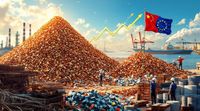Europe’s copper industry finds itself at the heart of a global tug-of-war, as China’s aggressive buying of scrap metal and shifting Western strategies for critical minerals create new supply chain headaches and policy dilemmas. In the first seven months of 2025 alone, China imported about 204,000 tons of copper scrap from EU nations—a 3.5% increase year-over-year, according to the European Commission’s Raw Materials Information System. That’s nearly half of all European copper scrap exports flowing east, a figure that’s left European smelters, especially in Germany, scrambling for raw materials.
The consequences have been swift and severe. German Economy Minister Katherina Reiche, speaking to Bloomberg News in September 2025, warned, “Large German copper smelters are no longer getting any raw materials” due to China’s purchasing power. The German Copper Institute has echoed these concerns, documenting supply chain disruptions that are rippling through the country’s vital automotive and electrical industries. With copper prices on the London Metal Exchange swinging between $9,000 and $10,000 per tonne over the past year, the stakes for manufacturers couldn’t be higher.
Why has copper scrap become such a hot commodity? The answer lies in its unique role in the green transition and the circular economy. Copper is perfectly recyclable—according to the Copper Development Association, it maintains its properties indefinitely, making it a cornerstone of sustainable industry. Processing scrap copper requires about 85% less energy than mining new ore, as the International Copper Association reports. That’s a huge win for emissions reduction and cost savings, especially as environmental regulations tighten across Europe and beyond.
But it’s not just about green credentials. Global copper demand is surging, projected to hit 30.1 million tonnes by 2030 (up from 25.2 million tonnes in 2023), driven by electrification and renewable energy projects, according to the International Energy Agency. Meanwhile, traditional mining is getting tougher and more expensive—Chile’s Codelco, the world’s largest copper producer, faces rising costs as ore grades decline and mines dig deeper. This has made recycled copper ever more attractive, not just for its lower carbon footprint but for its economic edge.
China’s role in this drama is outsized. Its domestic smelters have expanded rapidly, fueling an insatiable appetite for raw materials. With domestic scrap generation falling short of processing capacity (about 2.3 million tonnes annually, according to industry estimates), China has turned to global markets—especially Europe—to fill the gap. Chinese buyers are consistently outbidding their European counterparts, creating a supply crunch that’s threatening the continent’s manufacturing base.
The situation is further complicated by geopolitics. US-China trade tensions and tariffs have rerouted some American copper scrap shipments through third countries like Canada, Mexico, and Vietnam, making Europe an even more attractive target for Chinese buyers. The collapse in direct US-to-China shipments has intensified the squeeze on European supplies, fanning fears of a broader resource security crisis.
European policymakers are not sitting idly by. The EU has activated a customs surveillance system to track metal scrap movements, covering roughly 200 material categories including copper. The Steel and Metal Action Plan, adopted in 2025, has set a precedent for intervention in scrap metal markets. There are growing calls for a ban on copper scrap exports to certain non-OECD countries by 2027, mirroring restrictions already in place for some waste streams under the EU Waste Shipment Regulation. Industry groups are pushing for immediate restrictions to secure vital copper supplies for European manufacturers.
Integration of scrap retention policies into the Critical Raw Materials Act—which now lists copper among its 34 critical raw materials—could provide the legal foundation for more comprehensive export controls. Enhanced monitoring of trade flows and countermeasures against market manipulation are also on the table, as policymakers look for data-driven ways to manage the crisis.
This isn’t just an economic or industrial story—it’s a question of strategic autonomy. Copper is essential for Europe’s green transition, with the REPowerEU plan alone requiring a 35% increase in copper demand for renewable energy infrastructure by 2030. Retaining scrap supports emissions reduction targets, strengthens domestic industry, and reduces reliance on imports. But it also raises tough questions about the balance between free trade and resource security, as well as the future of Europe’s industrial ecosystem.
There are environmental angles to consider, too. Shipping scrap to China for processing increases transportation emissions—maritime transport generates about 0.5-0.8 tonnes of CO2 per tonne of material moved, according to Maritime Transport Efficiency data. European smelters operate under stricter environmental standards, offering regulatory advantages for local processing. Circular economy principles favor keeping scrap within Europe, creating closed-loop systems that minimize environmental impact and maximize resource efficiency.
Yet, the story doesn’t end at Europe’s borders. China is unlikely to take European restrictions lying down. Diversification of scrap sourcing from developing countries with less regulated export controls could offset any European bans. China has already ramped up investments in primary copper mining internationally, with a 40% increase in Latin American projects since 2020, according to CEPAL data. Retaliatory trade measures are possible, and the issue could become a bargaining chip in broader EU-China trade negotiations. China may frame any European restrictions as protectionist and in violation of WTO principles, raising the risk of escalation into wider resource nationalism conflicts.
Meanwhile, the broader landscape of critical minerals is shifting fast. On September 2, 2025, the US Department of the Interior and USGS expanded their draft list of critical minerals to 54 items, including copper, potash, and silicon. This move could open the door to US financing and fast-track permits for mining projects, further intensifying global competition for resources. TechMet, backed by the US Development Finance Corporation and Mercuria, launched a trading unit to bring specialty metals into non-China channels, while Australia’s Critical Metals Corp inked a decade-long deal to supply rare earth concentrates to a US Department of Defense-funded plant in Louisiana. All these efforts reflect a broader Western push to “friend-shore” supply chains and reduce reliance on China.
Producer countries are also making tough choices. Chile’s government is racing to finalize a lithium partnership between state copper giant Codelco and SQM before the next election, while several presidential candidates threaten to revisit or scrap the deal. In Bolivia, right-wing presidential candidate Jorge Quiroga has pledged to cancel multi-billion-dollar lithium contracts with Russian and Chinese firms, signaling a potential pivot toward Western partners. Such moves inject political volatility into global mineral supply chains, with billions of dollars in projects hanging in the balance.
For Europe, the copper scrap crisis is a microcosm of a larger transformation. The continent’s response—balancing domestic industry needs, environmental goals, and international obligations—will shape not only the future of its copper sector but also its broader approach to critical minerals and resource governance. The outcome will determine whether Europe can secure the raw materials it needs for the green transition, or whether it risks falling behind in the global race for strategic resources.
As policymakers and industry leaders weigh their next moves, one thing is clear: the fight over copper scrap is just the beginning of a new era in global resource politics, where minerals are no longer mere commodities, but vital assets in the struggle for economic and technological sovereignty.

